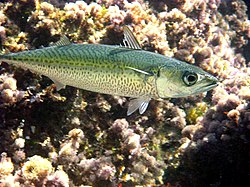| Atlantic chub mackerel | |
|---|---|
 | |
| Atlantic chub mackerel | |
| Scientific classification | |
| Kingdom: | Animalia |
| Phylum: | Chordata |
| Class: | Actinopterygii |
| Order: | Scombriformes |
| Family: | Scombridae |
| Genus: | Scomber |
| Species: | S. colias |
| Binomial name | |
| Scomber colias Gmelin, 1789 | |
| Synonyms | |
| |
Atlantic chub mackerel (Scomber colias), also known as Tinker mackerel, [2] is a pelagic schooling species of mackerel found in the Atlantic Ocean, the Mediterranean Sea, and the Black Sea. It was originally thought to be a subspecies of the chub mackerel Scomber japonicus colias .




